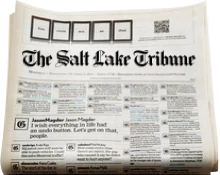This is an archived article that was published on sltrib.com in 2011, and information in the article may be outdated. It is provided only for personal research purposes and may not be reprinted.
Logan
Nobody avoids winning football games quite like the Utah State Aggies.
Three weeks after finding a way to lose a potential program-changing game at Auburn, the Aggies came back for more misery Saturday night at Romney Stadium.
USU's 35-34 double-overtime loss to Colorado State lasted that long and turned out that way mostly because a muffed punt gave the Rams a chance to tie the game with a touchdown and two-point conversion with 42 seconds remaining in regulation.
Just to make September more cruel for everybody involved, the Aggies staged another version of the Auburn meltdown in front of their home fans.
Seriously, how much more can one team and its followers take?
This whole night was so close to becoming everything that coach Gary Andersen pictured for his program. In his third season, the Aggies (1-2) attracted a huge crowd, enjoyed an atmosphere that resembled the usual frenzy of the nearby basketball arena and — for nearly 60 minutes — played the kind of defense that made Andersen's career as Utah's defensive coordinator.
And then it all crumbled, ultimately ending with a failure that resulted from Andersen's biggest decision as a head coach.
After everything that happened in this game, the conclusion of it all was running back Robert Turbin's being forced out of bounds well short of the goal line on a two-point conversion.
Even worse, that came after a pass-interference penalty gave the Aggies a second try for two. "I surely believe that we can score from the 11/2-yard line," Andersen said. "I'd do it again in one second."
The irony is that having played so well for so long, the Aggie defense wore down to the point where Andersen wanted to end the game right then and there, rather than ask any more of those guys. Evidence supports that strategy — except it backfired. After giving up only 182 total yards in regulation, USU had allowed the Rams to cover 25 yards rather easily on each of their two overtime possessions, taking a 35-28 lead.
So after Turbin's touchdown run on USU's first play of the second overtime, the home team took its game-winning opportunity. Two of them, actually.
"It's something that'll stick with me forever," Turbin said.
So let's review: The Aggies could not win this game when they were leading 21-13 and having CSU punt the ball to them, with USU's Eric Moats fumbling for the second time in the game. They could not win when they sent their defense onto the field with a 28-21 edge in the first overtime. They could not win when the Rams gave them a second chance on the two-point attempt.
Anyone believe the Aggies can win, period?
"It's just crushing to feel the emotion in the stadium," Andersen said, thinking mostly of the fans he desperately wanted to reward.
CSU was exactly the kind of nonconference opponent the Aggies should be facing. USU athletic director Scott Barnes has delivered just the right of mix of challenging and winnable games, with trips to Auburn and BYU and home games against Weber State, Colorado State and Wyoming.
More than anything, this schedule of regional, recognizable, beatable opponents has helped to stir interest in the Aggies. To sustain that following, USU absolutely had to take advantage of this setting and this opportunity.
And the Aggies blew it. Again.
"You have to learn from these kind of situations," Turbin said afterward.
If so, the Aggies should have qualified for graduate degrees by now.
Three weeks later, the Auburn loss has a rival.
"Colorado State's not good enough to beat us; I'm sorry," Turbin said. "We beat ourselves."
Twitter: @tribkurt

